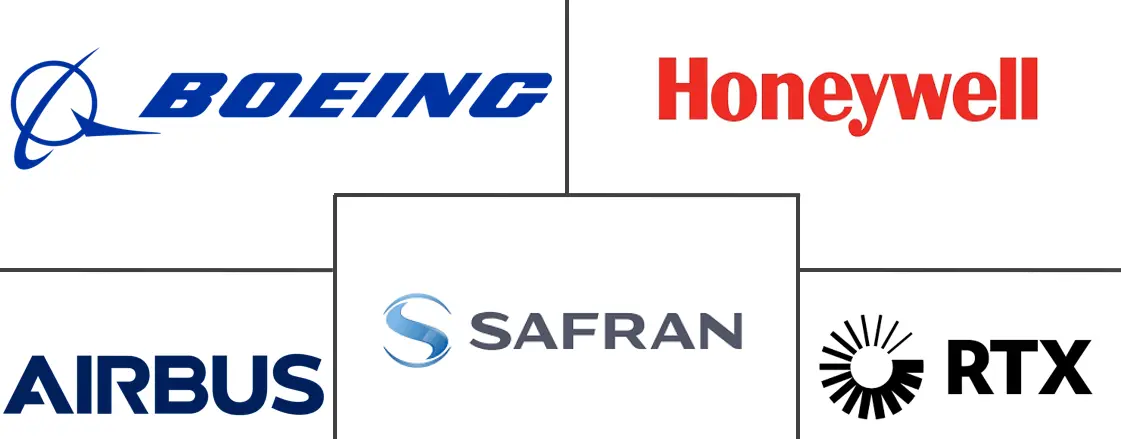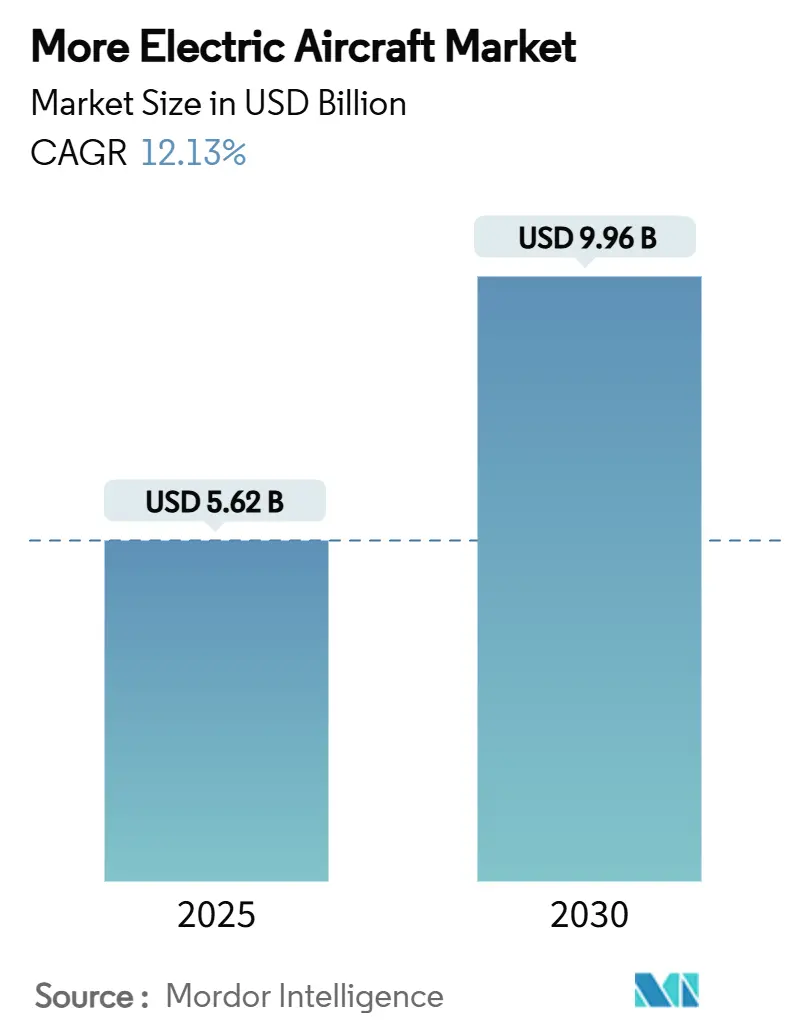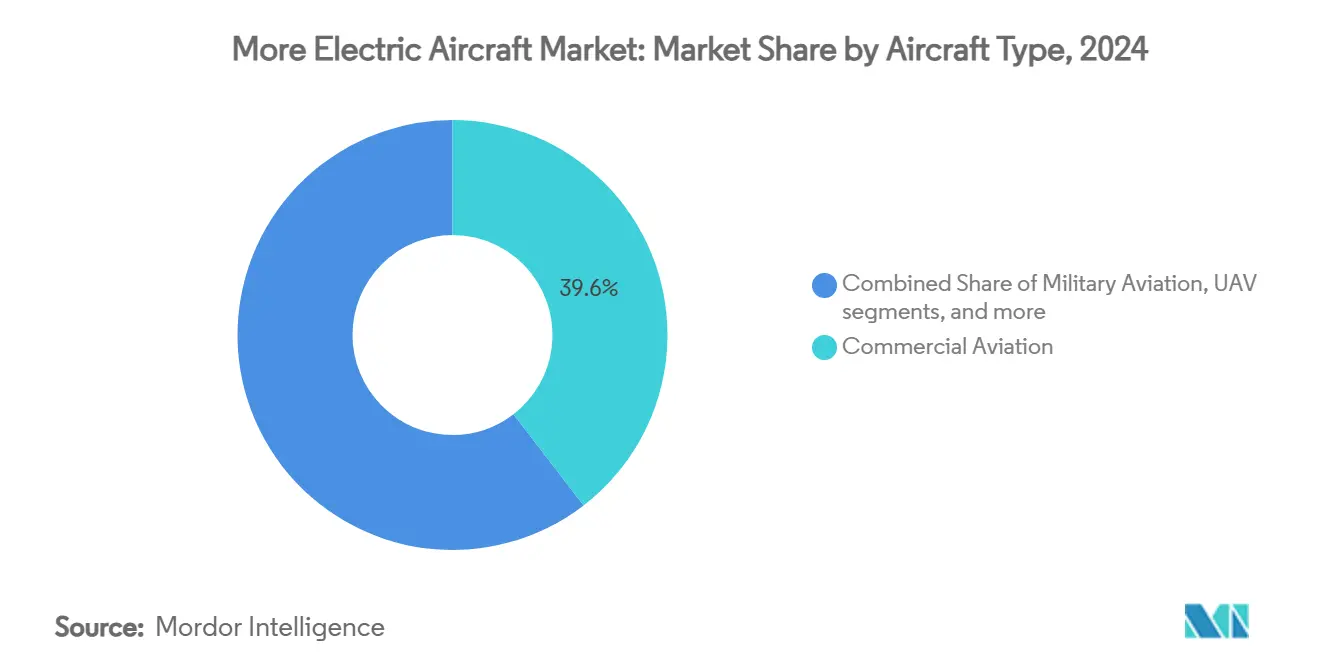More Electric Aircraft Market Size and Share
More Electric Aircraft Market Analysis by Mordor Intelligence
The more electric aircraft (MEA) market is valued at USD 5.62 billion in 2025 and is forecasted to reach a market size of USD 9.96 billion by 2030, advancing at a 12.13% CAGR. Rising fuel prices, carbon-reduction mandates, and the maturation of high-power electronics push airlines and airframers to swap hydraulic and pneumatic subsystems for electrical architectures. Airlines report fuel-burn savings of up to 20% when engines no longer bleed air for environmental control, while power-dense generators and solid-state batteries support longer electric endurance. Fixed-wing programs such as the B787 prove bleed-less operation in service, and eVTOL developers apply the same logic to urban missions. As a result, incumbents and start-ups race to secure wide-bandgap semiconductors, thermal control materials, and high-voltage certification slots to keep pace with demand.
Key Report Takeaways
- By aircraft type, commercial aviation held 39.56% of the more electric aircraft market share in 2024, whereas urban air mobility and eVTOL platforms are poised for the fastest expansion at a 15.65% CAGR through 2030.
- By platform, fixed-wing designs led with 63.55% of the more electric aircraft market share in 2024; rotary-wing and powered-lift programs outpace at a 12.4% CAGR to 2030.
- By system, power-generation and management hardware accounted for 56.75% of the more electric aircraft market size in 2024, while electromechanical actuation grows quickest at an 11.56% CAGR through 2030.
- By end-user, OEMs controlled 53.78% of 2024 value, yet the aftermarket segment accelerates at 12.55% CAGR through 2030.
- By geography, North America commanded 35.23% revenue in 2024, whereas Asia-Pacific registers the highest regional CAGR at 12.45% to 2030.
Global More Electric Aircraft Market Trends and Insights
Drivers Impact Analysis
| Driver | (~) % Impact on CAGR Forecast | Geographic Relevance | Impact Timeline |
|---|---|---|---|
| Electrification drive to cut fuel burn and CO₂ | +3.2% | Global | Medium term (2-4 years) |
| Global emission regulations tightening | +2.8% | North America and EU; spill-over to APAC | Short term (≤ 2 years) |
| High-power motors and SiC/GaN electronics | +2.1% | Global; early adoption in North America | Medium term (2-4 years) |
| Solid-state batteries enable power-spike loads | +1.9% | APAC core; spill-over to North America | Long term (≥ 4 years) |
| ESG-driven retrofit demand for APUs | +1.4% | North America and EU | Short term (≤ 2 years) |
| Stealth-focused electric actuation (defense) | +0.9% | North America; selective EU markets | Medium term (2-4 years) |
| Source: Mordor Intelligence | |||
Electrification Drive to Cut Fuel Burn and CO₂
Fuel accounts for 20%-30% of airline operating expense, making kilowatt-class electric powertrains economically attractive in addition to their emission benefits. GE Aerospace’s CLEEN III demonstration delivers a 90 kW starter-generator that removes bleed-air plumbing and lets turbofan cores run closer to optimum thrust settings.[1]GE Aerospace, “CLEEN III Electric Propulsion Demonstration,” geaerospace.com Collins Aerospace’s bleed-less environmental control pack on the 787 illustrates how electrical subsystems lower carbon output while easing maintenance planning.[2]Collins Aerospace, “Bleed-less Environmental Control Systems,” collinsaerospace.com Airlines thus gain predictable inspection intervals and fewer fluid leaks, reducing unscheduled ground time. These dual financial and compliance rewards reinforce continuous investment in electrified line-fit and retrofit programs across fleet types.
Global Emission Regulations Tightening
Binding rules now supplant voluntary pledges. The US Federal Aviation Administration (FAA) adopted fuel-efficiency standards effective April 2024 that set maximum fuel per seat-kilometer for new jets.[3]Federal Aviation Administration, “Final Rule on Airplane Fuel-Efficiency Standards,” faa.gov The European “ReFuelEU” mandate obliges carriers to uplift 6% sustainable aviation fuel by 2030 and 70% by 2050, prompting hybrid-electric architectures that blend drop-in fuels with electric boost. ICAO’s global offset scheme requires verifiable emission cuts, forcing OEMs to accelerate electrical integration because incremental engine tweaks cannot satisfy near-term compliance windows. Airbus, for example, publicly targets a zero-emission commercial model by 2035 to stay within regulatory guardrails.
High-Power Motors and SiC/GaN Electronics
Silicon-carbide (SiC) and gallium-nitride (GaN) switches halve conduction losses relative to silicon, enabling megawatt-scale motors without prohibitive weight. A NASA-GE demonstrator pairs a 1 MW electric machine with SiC drives to show 20% cruise fuel savings on a single-aisle airframe. Device operation at 800 V-1,000 V reduces cable mass while tolerating higher junction temperatures, critical in cramped nacelle bays. Although automotive uptake has matured, wafer output has matured, and aerospace-grade lots remain limited, making strategic supply agreements a competitive differentiator. Collins Aerospace, therefore, opened a dedicated power-electronics lab in Rockford, Illinois, to design chips in-house and secure capacity ahead of volume needs.
Solid-State Batteries Enable Power-Spike Loads
Solid-state chemistries raise gravimetric energy above 500 Wh/kg and remove flammable liquid electrolytes. CATL’s condensed-battery prototype reached aviation testing in 2025 and aims for service entry by 2028 with stackable, fire-resistant packs. NASA’s sulfur-selenium cells double the current lithium-ion energy per kilogram and promise eVTOL ranges of 200 miles without hybrid backup.[4]NASA, “Megawatt-Class Electrified Powertrain Flight Demonstration,” nasa.gov High discharge rates cover peak lift and landing loads, slimming auxiliary power units in some architectures. Certification tracks for solid-state modules align with urban air-mobility timelines, suggesting technology and regulatory readiness may converge before decade-end.
Restraints Impact Analysis
| Restraint | (~) % Impact on CAGR Forecast | Geographic Relevance | Impact Timeline |
|---|---|---|---|
| High-voltage certification hurdles | -2.1% | Global; standards vary | Medium term (2-4 years) |
| Thermal reliability of dense power modules | -1.8% | Global | Short term (≤ 2 years) |
| Scarcity of aero-grade SiC supply chain | -1.5% | Global; concentration in Asia | Medium term (2-4 years) |
| Airport MRO infrastructure lag | -1.2% | Global; slower adoption in emerging markets | Long term (≥ 4 years) |
| Source: Mordor Intelligence | |||
High-Voltage Certification Hurdles
Electric propulsion routinely exceeds 1,000 V DC, yet historical regulations focus on 270 V architectures. The FAA issued special conditions for BETA Technologies’ H500A to address new arc-fault and insulation-breakdown modes. Divergent rule-making between the FAA and EASA complicates global validation, obliging developers to engineer for multiple worst-case scenarios. Boeing’s B777-9 still faces additional scrutiny for operations without conventional electrical power, underscoring how legacy programs experience certification delays when voltage envelopes widen. These uncertainties lengthen development cycles and inflate budgets, tempering the headline growth rate of the more electric aircraft market.
Thermal Reliability of Dense Power Modules
Even at 99% efficiency, megawatt-class electronics shed kilowatts of waste heat into confined fuselage spaces. Honeywell’s European consortium found that hybrid-electric single-aisles must dissipate more than 1 MW during climb, surpassing the capacity of bleed-air environmental control systems. EU-funded ICOPE research, therefore, advances micro-channel heat sinks and phase-change materials tailored to high-altitude pressure regimes. Thermal cycling also stresses solder joints in SiC modules, endangering reliability if not mitigated through robust packaging. Until cooling architectures mature, manufacturers balance power density against service-life risk, constraining the pace of electrification.
Segment Analysis
By Aircraft Type: Commercial Leadership and eVTOL Surge
Commercial airframes contributed 39.56% of the more electric aircraft market in 2024 as airlines replaced hydraulics with distributed electrical subsystems to curb maintenance outlay. Carriers highlight predictable life-cycle costs when line-replaceable units are solid-state rather than fluid-powered. Meanwhile, the eVTOL category posts a 15.65% CAGR to 2030, signaling rising investor confidence in city-pair air-taxi operations. Certification milestones by Joby and Archer shifted perceptions from concept to near-term service, unlocking fleet orders from regional operators. Military programs adopt electric actuation chiefly for radar-signature reduction, while business aviation follows for lower cabin noise and airport emissions.
The segment divergence suggests the more electric aircraft market may recalibrate traditional demand metrics. JSX’s plan to accept more than 300 hybrid-electric regional aircraft after 2028 illustrates how regional carriers will leapfrog older fleets when viable. Accelerated orders shrink developmental lead times, forcing supply chains to allocate semiconductors first to eVTOL founders. Limited cell production for high-cycle batteries thus becomes a gating item for legacy narrow-body retrofits. Still, retrofit kits for older commercial types gain traction where full fleet renewal is financially prohibitive, ensuring a balanced order mix across aircraft classes.
Note: Segment shares of all individual segments available upon report purchase
By Platform: Fixed-Wing Dominance, Rotary-Wing Momentum
Fixed-wing designs held 63.55% of the more electric aircraft market size in 2024, thanks to certified reference programs such as the B787 and A350 demonstrating electric environmental control in revenue service. These examples reassure regulators and lessors when approving high-voltage retrofits to narrow-body fleets. At the same time, rotary-wing and powered-lift concepts expand at 12.4% CAGR, buoyed by the step-change in hover efficiency that direct-drive electric motors deliver.
DARPA’s XRQ-73 hybrid-electric drone blends rotor lift with fixed-wing cruise and showcases how power electronics endow vertical assets with stealth and endurance. Electra’s short-takeoff regional demonstrator collapses the divide further, hinting that future taxonomy will focus on mission profile rather than wing planform. Rotary programs also exploit the absence of gearbox lubrication lines, cutting weight and maintenance. This blurring of categories could spur unified certification frameworks, smoothing entry for unconventional layouts and sustaining platform diversity inside the more electric aircraft market.
By System: Power Generation Leads as Actuation Accelerates
Power-generation and management units represented 56.75% of 2024 revenue, reflecting airlines’ need for stable, high-voltage buses before secondary subsystems transition. Modular starter-generators enable gate-to-gate electrical power, while smart converters stabilize frequency and mitigate fault cascades. Integrated racks simplify wiring runs and reduce electromagnetic interference, a critical trait when voltages approach 1 kV.
Actuation hardware advances fastest at an 11.56% CAGR through 2030, driven by demand for precision servo-controls that outperform hydraulics during dynamic maneuvers. Saab’s flight-qualified electromechanical actuators evidence higher positional accuracy, plus leak-free operation that improves aircraft dispatch reliability.[5]Saab AB, “Electromechanical Actuation for Flight Controls,” saab.com Thermal-management elements gain relevance in lock-step, as compact pumps and liquid-cold plates become mandatory at megawatt scales. Engine-start converters, once pneumatic, turn fully electric to permit autonomous pushback without ground carts, cutting turnaround time. These trends re-order supplier hierarchies: semiconductor foundries and thermal specialists ascend alongside legacy propulsion primes.
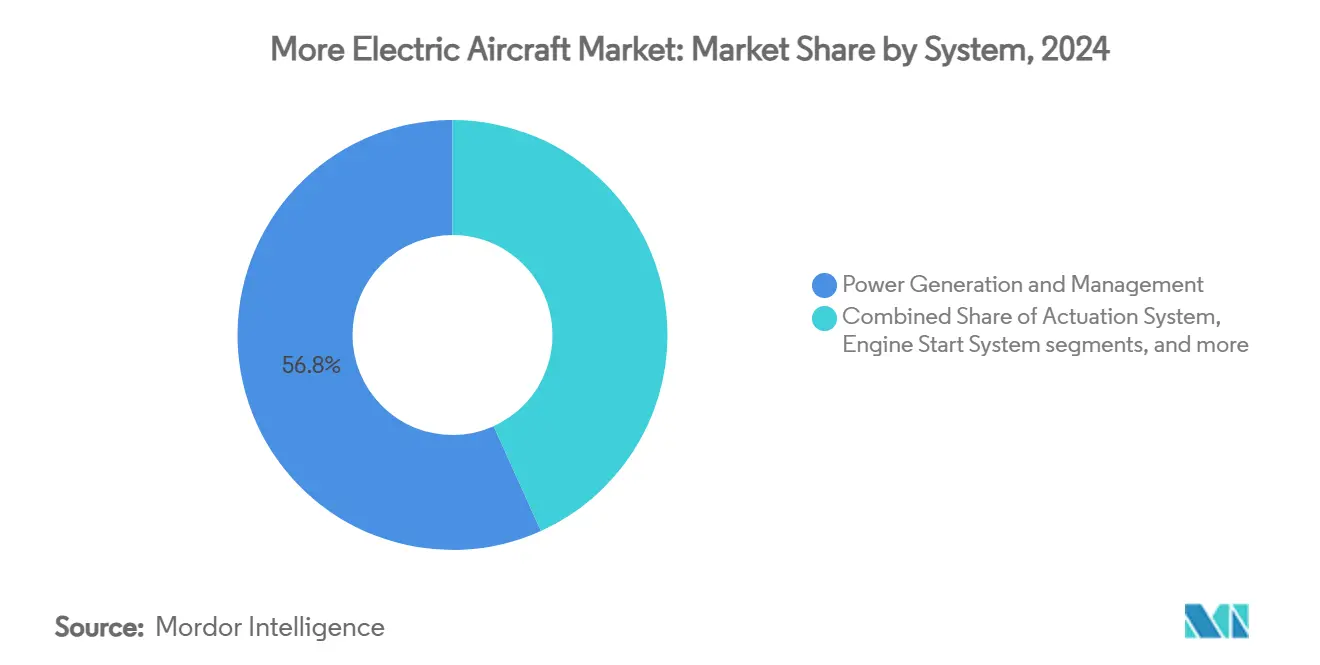
Note: Segment shares of all individual segments available upon report purchase
By End-User: OEM Control, Aftermarket Upside
OEMs retained 53.78% of the value share in 2024 due to design authority and direct line-fit sales. They embed integrated flight-by-wire and electric bleed-less packs at the build stage, capturing premium margins. In contrast, aftermarket revenue grows 12.55% annually to 2030 as electric subsystems demand new diagnostic tools and repair competencies. Predictive maintenance portals that ingest high-frequency power-quality data become subscription products for airlines.
Airbus projects the wider services pool to reach USD 290 billion by 2043, with electric-specific monitoring as a core pillar. Collins Aerospace already trains MRO technicians on arc-flash safety and high-energy battery handling, betting that post-delivery support will eclipse equipment margin across a 30-year aircraft life. Independent repair stations invest in insulated tooling and battery-storage bunkers to compete, but capital requirements act as a barrier, reinforcing OEM leverage. This shift underscores why competence in lifetime service propositions now influences aircraft selection alongside acquisition price.
Geography Analysis
North America held 35.23% of 2024 spending as defense budgets backed megawatt demonstrators and the FAA provided early pathways for electric propulsion certification. Established Tier-1 suppliers in the United States anchor a mature ecosystem that co-locates research laboratories, test rigs, and human-capital pipelines. NASA’s Electrified Powertrain Flight Demonstration program pairs GE and Boeing engineers to flight-test hybrid propulsion on a regional platform by 2027, reinforcing regional momentum.
Europe ranks second by value, buoyed by Clean Aviation grants and airport decarbonization policies. EU projects such as GOLIAT and EcoPulse channel public funds into liquid-hydrogen handling, superconducting cables, and hybrid-electric flight tests. EASA harmonization with the FAA accelerates transatlantic validation for eVTOLs, shortening time-to-market for dual-registry operators. Nevertheless, European suppliers face currency inflation in semiconductor procurement, prompting joint ventures with Asian foundries to secure wafer allocations.
Asia-Pacific records the highest growth at a 12.45% CAGR. China’s Civil Aviation Administration earmarked dedicated low-altitude corridors for eVTOL logistics and passenger shuttles, compressing commercial deployment timelines. State plans to build a trillion-yuan general-aviation industry by 2030, injecting subsidies and regulatory certainty to attract foreign Tier-2 suppliers. Japan and South Korea focus on urban demonstrator flights for Expo-type events, offering a showcase before broader certification. However, airport readiness lags. India explores electric regional turboprops for short-haul routes under the UDAN connectivity scheme. The region’s diverse market entries collectively translate into sustained order books for battery, motor, and avionics vendors, ensuring Asia-Pacific remains the principal volume driver in the more electric aircraft market.
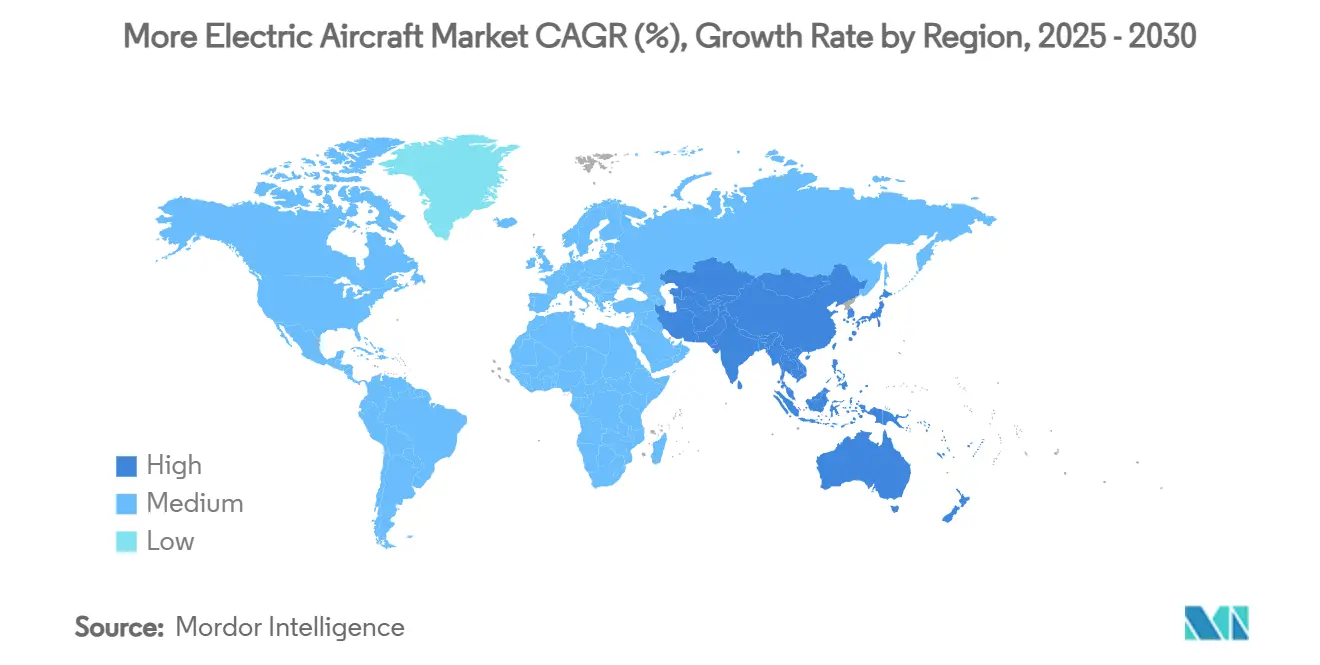
Competitive Landscape
The more electric aircraft market is moderately concentrated. Legacy primes—Collins Aerospace, Honeywell, Safran, GE Aerospace, and Rolls-Royce—command program-management prowess and hold deep certification experience that newcomers cannot replicate quickly. All five invested in dedicated power-electronics test halls between 2024 and 2025, signaling a strategic pivot from turbine-only portfolios to full electrified propulsion stacks.
Acquisition remains the favoured route to close technology gaps. Honeywell purchased battery-management software start-ups to complement its flight-control line. Safran absorbed ePropelled’s motor IP, integrating stator manufacturing into its Villeurbanne facility. GE Aerospace partnered with magniX to co-develop megawatt generators for commuter aircraft, using GE’s additive manufacturing to speed stator prototyping. Such moves tighten vertical control over critical path items—power electronics, thermal loops, and certification data packages—leaving component-only firms vulnerable unless they join broader ecosystems.
Start-ups differentiate through agility and niche focus. Wright Electric emphasizes 186-seat short-haul missions to replace aging narrow-bodies, whereas Ampaire concentrates on hybrid conversions of existing regional aircraft to leverage current airframes. Joby Aviation’s FAA special conditions for its JAS4-1 grant early-mover status and potential licensing revenue, establishing regulatory barriers for later entrants. As wide-bandgap chips and advanced batteries trend toward commodity status by 2030, sustainable competitive advantage will likely hinge on integration skill and digital twins that optimize system-of-systems performance rather than on single component superiority.
More Electric Aircraft Industry Leaders
-
Airbus SE
-
The Boeing Company
-
Safran SA
-
Honeywell International Inc.
-
RTX Corporation
- *Disclaimer: Major Players sorted in no particular order
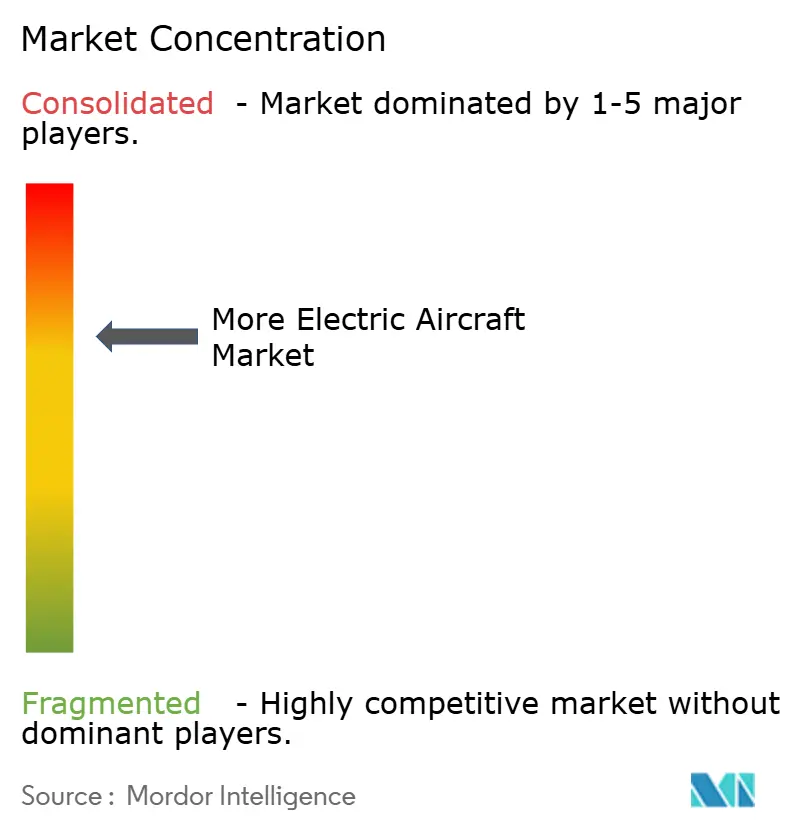
Recent Industry Developments
- May 2025: Vertical Aerospace and Honeywell expanded their partnership to bring the VX4 eVTOL to market, with a projected contract value of USD 1 billion and at least 150 units by 2030.
- March 2025: RTX’s Pratt & Whitney and Collins Aerospace led engine integration and supplied power units for JetZero’s blended-wing demonstrator, which targets a 50% fuel-burn reduction.
- February 2025: H55 and Aerovolt UK partnered to develop electric aircraft training and charging networks, establishing infrastructure across the UK market.
- December 2024: Regal Rexnord and Honeywell announced multi-year cooperation on electro-mechanical components for advanced air-mobility aircraft.
Global More Electric Aircraft Market Report Scope
In more electric aircraft (MEA), electrical systems replace most pneumatic systems found on traditional commercial airplanes. In conventional aircraft, the engines use bleed air to cater to the power requirements of most secondary airplane systems. In the no-bleed architecture found in MEA, the engines provide power to shaft-driven generators, catering to the power needs of most airplane systems. In MEA, hydraulic systems are driven by engines and electric-motor-driven hydraulic pumps, and electrical systems are driven by engines and auxiliary-power-unit (APU)-driven generators.
The more electric aircraft market is segmented by application and geography. By application, the market has been segmented into commercial, military, and general aviation. The report also covers the market sizes and forecasts for the more electric aircraft market in major countries across different regions. For each segment, the market size is provided in terms of value (USD).
| By Aircraft Type | Commercial Aviation | ||
| Military Aviation | |||
| Business and General Aviation | |||
| Unmanned Aerial Vehicles (UAV) | |||
| Urban Air Mobility/eVTOL | |||
| By Platform | Fixed Wing | ||
| Rotary Wing | |||
| By System | Power Generation and Management | Electric Power Generation | |
| Power Conversion | |||
| Power Distribution | |||
| Actuation System | Flight Control Actuation | ||
| Landing Gear Actuation | |||
| Thermal Management System | |||
| Engine Start System | |||
| Environmental Control System | |||
| Others | |||
| By End-user | OEM | ||
| Aftermarket | |||
| By Geography | North America | United States | |
| Canada | |||
| Mexico | |||
| Europe | United Kingdom | ||
| France | |||
| Germany | |||
| Rest of Europe | |||
| Asia-Pacific | China | ||
| Japan | |||
| India | |||
| South Korea | |||
| Rest of Asia-Pacific | |||
| South America | Brazil | ||
| Rest of South America | |||
| Middle East and Africa | Middle East | Saudi Arabia | |
| United Arab Emirates | |||
| Rest of Middle East | |||
| Africa | South Africa | ||
| Rest of Africa | |||
| Commercial Aviation |
| Military Aviation |
| Business and General Aviation |
| Unmanned Aerial Vehicles (UAV) |
| Urban Air Mobility/eVTOL |
| Fixed Wing |
| Rotary Wing |
| Power Generation and Management | Electric Power Generation |
| Power Conversion | |
| Power Distribution | |
| Actuation System | Flight Control Actuation |
| Landing Gear Actuation | |
| Thermal Management System | |
| Engine Start System | |
| Environmental Control System | |
| Others |
| OEM |
| Aftermarket |
| North America | United States | |
| Canada | ||
| Mexico | ||
| Europe | United Kingdom | |
| France | ||
| Germany | ||
| Rest of Europe | ||
| Asia-Pacific | China | |
| Japan | ||
| India | ||
| South Korea | ||
| Rest of Asia-Pacific | ||
| South America | Brazil | |
| Rest of South America | ||
| Middle East and Africa | Middle East | Saudi Arabia |
| United Arab Emirates | ||
| Rest of Middle East | ||
| Africa | South Africa | |
| Rest of Africa | ||
Key Questions Answered in the Report
What is the current value of the more electric aircraft market?
The market stands at USD 5.62 billion in 2025 and is projected to climb to USD 9.96 billion by 2030, advancing at a 12.13% CAGR.
Which aircraft category is growing fastest?
Urban air-mobility and eVTOL platforms record the highest growth at a 15.65% CAGR through 2030.
Why do airlines favor electric actuation over hydraulics?
Electric actuators cut maintenance, prevent fluid leaks, and integrate seamlessly with predictive-maintenance software, improving dispatch reliability.
Which region leads demand today, and which region grows quickest?
North America leads in 2025 with 35.23% revenue, while Asia-Pacific posts the steepest growth at 12.45% CAGR.
What technologies most influence future adoption?
Wide-bandgap SiC/GaN power electronics, solid-state batteries above 500 Wh/kg, and megawatt-class starter-generators define the performance envelope for next-generation electric aircraft.
How will the aftermarket evolve for electric aircraft?
The aftermarket is expected to outpace OEM sales at 12.55% CAGR as airlines require specialized training, insulated tooling, and digital monitoring to service high-voltage systems.
Page last updated on:
